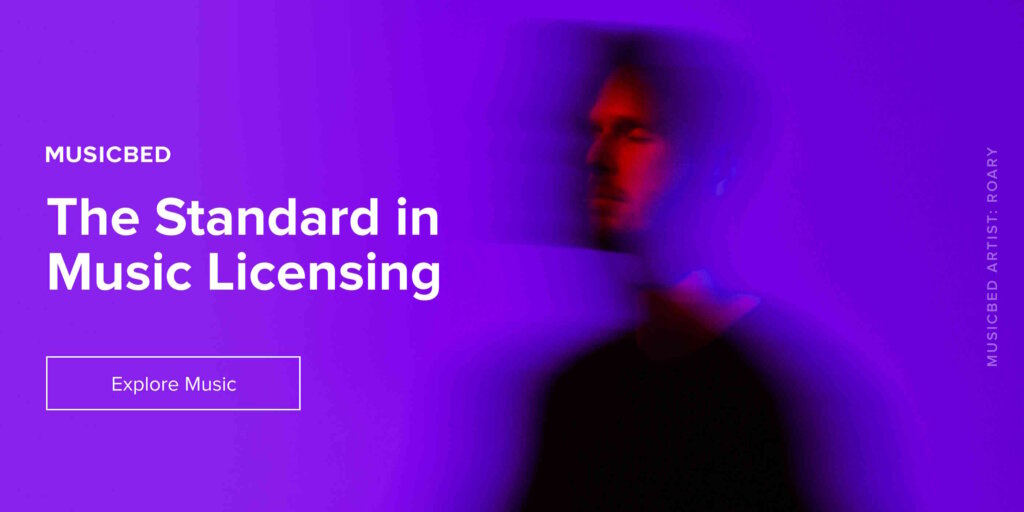What are the best video sharing sites for creators? How to monetize videos online? These are the most commonly asked questions for any online creator and the answer can come in all shapes and sizes. The good news is that there are a plethora of great options when it comes to the best platforms to share videos. We’re a bit spoiled for choice, but it can also be overwhelming.
To help you navigate and decide where to post your videos, we’ve put together a guide covering all the top sites, considering the free options and monetization opportunities, as well as the importance of music licensing.
Top Platforms for Sharing Videos
Below, we’ve taken each of the best platforms to share videos today and analyzed them accordingly. You should consider based on your own needs, primarily:
- Is this the right audience for you?
- What type of videos does the platform host (long form, or short form, vertical or landscape?)
- Does the platform have promising reach?
- How much time and work is required to manage the platform?
- What are the monetization options available to you?

YouTube
YouTube is the world’s second-most visited website behind Google and by far the most popular video-hosting platform on the internet. In other words, it has a huge reach. It’s quite amazing that with a few clicks of a button you can upload your video for free and have it seen by just about anyone in the world. With a great monetization programme and soaring popularity, YouTube is often the first port of call for video creators.
There are a number of ways to monetize your YouTube channel:
- Ad Revenue – YouTube is paid by companies to have their advertising run on your video. When you’re eligible to sign up to the YouTube partner programme and monetize your channel, every time someone clicks and watches your video with these ads, you’ll get a 55% cut of that revenue.
- Sponsorships and affiliate marketing – many creators will also run paid sponsorship ads in their videos as a way to generate an income. This helps them to run the channel and make a living.
- Other revenue – if you build a successful channel on YouTube with a large following, you may even be able to sell merch and products.
To succeed on YouTube, you’ll need to master creating engaging, accurate thumbnails that really grab people’s attention and get them to click. Alongside that, you’ll need to optimize your SEO and stick to a consistent, frequent upload schedule.
Facebook & Instagram
Facebook and Instagram are home to vast user bases that cover all the demographics. If you post a video here, there’s always a good chance it’ll be seen by the people who are interested in the type of content you create. From travel to comedy, fashion and everything in between, this is a great option for sharing videos.
Similar to YouTube’s ad revenue programme, there are in-stream ads that run on Facebook Watch, where you’ll receive 55% of the cut. For most content creators on Facebook and Instagram though, it’s most about sponsorship deals and branded content. When you build a dedicated audience in a particular niche (hiking or baking, for example), there are brands who will pay you to tap into that.
To maximize engagement on these platforms, you’ll need a quick, snappy intro that grabs people’s attention and stops them scrolling. You’ll also want to make full use of all the features, including Stories, where you can share personal updates and vlog-like elements of your day-to-day, as well as going live and building a strong connection with your audience.
Twitch
Twitch is the go-to platform for live streaming, and it’s particularly popular amongst gamers. YouTube certainly wants to muscle in on the action here, so it’s worth evaluating which would work best for you.
To make money on Twitch there are a number of subscription models which allow a viewer to pay to support your channel in return for perks such as ad-free viewing and better access. There’s also Bits – a virtual good that your viewers can use to “cheer” in chat and show support. When a Bit is used, the streamer receives $0.01, which can add up if your audiences are large.
Additionally, Twitch streamers can run ad breaks on their live streams to generate income, as well as take sponsorship and branded deals. Twitch is a platform all about building a community by interacting with your viewers and entertaining. The more you can entertain and connect during your live streams, the more people will keep on coming back to watch the next one.

TikTok
TiKTok is the go-to short-form video platform. Users (typically young Gen Z) are highly engaged, often creating and sharing short-form videos, participating in trends and interacting through likes, comments and shares. The potential to go viral here is really high.
In terms of making money on TikTok, there are a few options. Just like the other platforms, you’ll always be able to look at sponsorship and brand partnerships. Additionally, if you meet the criteria then you can sign up to the TikTok Creator Rewards Programme, which will pay you for your content depending on factors such as originality, play duration, audience engagement and search value.
On TikTok, it’s all about tapping into what’s happening right now. You need to create engaging, relevant content by checking out the latest hashtags and trends and seeing how you can become part of that conversation.
X (Twitter.com)
It will always be Twitter, sorry. Twitter continues to be the most social of the social media apps – it’s where conversation, debate and online chatter about the latest news and trends all take place. Think of it as the “water cooler” of the internet.
To be successful on Twitter with video, you need to post short, engaging content that taps into the online chatter. What are people talking about? What’s trending right now? Engaging with trends by using hashtags and holding conversations within those arenas can help you grow quickly.
In terms of monetization, there’s the Amplify Pre-Roll program – an opt-in advertising program that can serve pre-roll against your premium video content shared on Twitter. Meanwhile, Super Follows can help you earn monthly revenue by offering an extra level of content and interaction as a monthly subscription.
LinkedIn is a very focused niche when it comes to social media, but it can be lucrative. This is the top platform for online professional networking and business, and your videos should reflect that.
You need to create informative, professional content that A) targets the right audience and B) offers real value to that audience. If you can do that correctly, the potential for success on the platform is high.
In terms of monetizing, LinkedIn is all about building your personal brand and influence. Off the back of this, you may be able to secure brand deals and sponsorships, as well as speaking engagements and other industry-related jobs.
Dailymotion
Dailymotion is a popular alternative to YouTube. While it may not command the huge audiences that YouTube does, it has several revenue sharing models and advertising opportunities and it can be leveraged for niche content.
Just like YouTube, Once you become a Partner, you have the opportunity to promote your content through a Dailymotion channel and start earning revenues from your uploaded videos. Again, just like YouTube, there’s always the possibility of sponsorship and brand deals, as well as an added incentive of selling premium content to your audience such as courses, webinars and tutorials.
Dailymotion is ultimately a niche market, and your videos should reflect that. You should provide a predictable, consistent style of video focused on a niche. At the end of the day, a loyal audience engaging regularly with your videos is much more valuable than one-off viewers.
Video Hosting Platforms
Alongside social media, you’ve also got the option of video hosting platforms. These types of platforms aren’t necessarily about virality, but more about professional filmmaking. They may be preferred by some filmmakers for their advanced privacy options, customization and video analytics.
Vimeo
Vimeo is considered by many professional filmmakers to be the best platform for high-quality video hosting. If you want to share your best work in the highest possible quality and detail, you use Vimeo.
Vimeo also comes with some great advanced privacy options. For example, if you want to show your latest work in a new showreel but don’t want it to be seen publicly, you can password protect the video to ensure only those you want can watch. One of the main reasons Vimeo is loved by professionals is the clean, ad-free environment. Additionally, because non-paying users are limited in the amount of content they can upload, it keeps the site’s content more focused and streamlined to what really matters for this community.
This is a platform all about hosting your work and showing it off in the best way possible.
Wistia
Wistia is a platform very much focused on video marketing and business. As you’d expect, they have some fantastic lead generation tools, detailed analytics and great customization options to suit all your marketing needs.
Let’s say you’re a marketer aiming to generate leads and track video performance to see how it can convert to sales of a new product or service. Wistia has a specific email campaign link feature so that you can include videos in your marketing emails. Using the email merge tag generated by Wistia, you simply paste it into the body of your email and then you’ll be able to track the success with detailed analytics on the video performance and generated leads.
Uscreen.tv
Uscreen.tv is an all-in-one video membership platform that enables creators to scale their businesses through web, apps, built-in community and live streaming features. It allows you to create your own mobile and TV apps without needing to learn any coding, providing plenty of community building tools that enable you to forge a strong bond with your audience and monetize your video content through subscriptions.
For example, let’s say you’re a yoga teacher. Using Uscreen.tv you can create a series of premium workouts, online courses and live stream classes that members can pay to access. This creates a recurring revenue stream through your video content.

What Should Video Creators Know Before Publishing Their Videos?
With so much online content out there, you need to follow a few golden rules if you want to stand out. First and foremost, understand the nature of the video platform you’re creating for. A video that performs well on YouTube may not necessarily be a hit on TikTok. You need to understand your target audience – what are their preferences and viewing habits? If you think like a viewer, you stand a higher chance of creating something that really resonates with them.
Whatever platform you’re uploading to, you have to make sure it’s high quality in terms of the production value. Additionally, is the storytelling engaging? Is your message clear?
In terms of monetizing and SEO optimization, you’ll want to pay attention and target keywords, tags and descriptions. All of these factors combine to enhance the discoverability of your video.
Other Practical Tips
Once your video is posted, you still have plenty of work to do. If you want to have a real impact online then you need to remain consistent – stick to a realistic, regular posting schedule over the course of several months and years.
Every time you post, you need to be in the comments engaging with your audience. If someone’s taken the time out of their busy day to click, watch and then comment on your video, they deserve a reply! By engaging with your audience, you also get valuable feedback and insight into what your viewers want to see more of.
To further boost your video’s impact and grow your audience, consider how you can promote your videos across various different social media platforms, and look at collaborations with similar-sized content creators in your chosen niche.
While you’re doing all of this, ensure that you pay close attention to the analytics tools available to you. By tracking a video’s performance, you can identify key retention metrics and refine your content strategy going forward, improving future content.
Music Licensing
It’s worth remembering that if you want to create great videos, then you’ll need great music. And if you want to monetize those videos, then that music needs to be correctly licensed. Music licenses matter because if you don’t obtain the correct rights and clearances to use the music you want in your films, it can lead to very lengthy, costly, stressful legal battles over copyright issues.
At Musicbed, we have a catalog of over 50,000 licensed, ready-to-use songs from over 1,500 artists around the world, all available to you for a fair-priced monthly subscription. We’re the go-to resource for high-quality cinematic music that can immediately elevate the production value of any video. Even if we don’t have what you need immediately, we’re able to work closely with our artists to create a custom piece of music that’s just right for your film.
Wrapping up
So, that’s our rundown of the best video sharing sites for creators, as well as some of the top video hosting platforms. When you’re first starting out, it’s natural to take a while to find your voice and style.
Filmmakers and creators need to experiment and try out the various different platforms to see what does and doesn’t work for them. While it’d make our lives a lot easier, there’s no one-size-fits-all remedy here. By applying the tips provided here to each platform, you’ll be able to find the best way forward for you and your needs as an online creator.






















































































